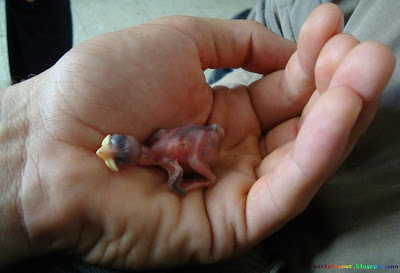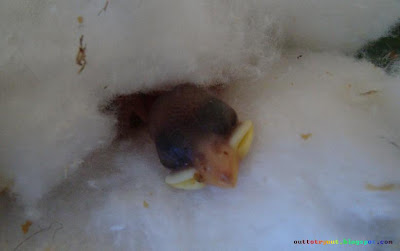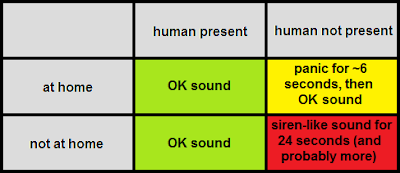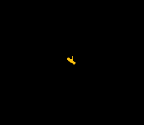
(Piolín is pronounced [piɔˈli:n], and it is the Spanish name of Tweety)
My niece found Piolín in June, saving him (or her... I have here the same problem I had with Patxi) from certain death, as he fell from his nest on a very hot day (under the Sun it must have been around 40ºC), lying on one side of a road. You can see a small wound on his back, probably caused by the fall.
As I discovered later, after some research, and despite his aspect, Piolín was not an ET, but a baby sparrow. When we found him he was one to three days old. He could not be quite older than that, because he had not even opened his eyes yet.
We started feeding him with some water and wet bread, and, as this video shows, he was hungry:
I observed that Piolín, as every baby, used to sleep or rest a lot when there was no activity around. But when he felt my presence, he always opened his big mouth, asking for food. He was striving for life, and did not give up at all. Bird parents must be very hard workers, as these babies request a huge amount of food! But when Piolín's tummy was full, our friend simply started resting again.
There was a difference between resting alone and resting with mum: when he felt I was near, he used to tweet. When he felt he was alone, he used to keep quiet. Probably this is so, because he has to tell his parents in some way he is alive and OK. Otherwise, the parents could think he died, and so they would start worrying about the other babies.
But if you are a baby bird, and you are alone, you will get more chances to survive if you keep quiet, or otherwise you could be discovered by an undesired predator.
The experiment
Well, that was what I thought, but... was it really so? Or was just my imagination? After all this is a blog about experiments, no matter how simple they are. And every experiment needs an idea to check, predictions (we just guess something from our idea), measurements (to check if they fit what we predicted) and conclusions.
So, the idea to check here is:
The prediction is simple: if I touch Piolín, he will tweet more times per minute than if I don't. So, I started counting how many tweets he did per minute. In the next video you can see a sample:
Even if I was covering him with my hand, I was not pressing at all. I was just touching him.
And here are the measurements:
- On my hand (covering him) > 38, 42 and 54 tweets per minute in three different moments
- On my open hand (not covering him) > 18 tweets per minute
- Touching him directly, while being in his nest > 65 tweets per minute
- Touching him through some cotton in his nest > 63 tweets per minute
- In his nest, not touching him > 0 tweets per minute
- In his nest, not touching him, but with my hand near him (so he could perhaps feel my warmth) > 0 tweets per minute
- In his nest, covered with cotton, but not touching him > 0 tweets per minute
- In his nest, covered with cotton, two minutes after being touched by me > 26 tweets per minute
Every measurement has been made leaving enough time in between, so each time I started from "zero tweets per minute". This is important, as we will see soon that Piolín kept tweeting for a few minutes each time he had been touched.
And the conclusion: it is obvious that there is a big difference in his message if he feels the mild pressure of my fingers/hand than otherwise. By tweeting, he is trying to express something to his parents, probably just to let them know he is OK.
As I said, Piolín used to keep tweeting for a while after he was left alone (about two or three minutes). Here you can see him alone in the nest we made for him, a few minutes after the previous video (where he was in my hand):
What about Piolín?
Very unfortunately, this story has a very sad ending. He did not make it. The day later, while we thought he was sleeping, he started choking on his own vomit, and when we arrived it was too late. Everything happened in just five minutes. We felt really unhappy about this, but at least we gave him a chance and it has been a very enriching experience for us (even if it has been really exhausting, as they need to be fed every 20-45 minutes).

Piolín sleeping
However, if you ever find a baby sparrow, don't be discouraged, as you have many chances to help him become an adult, healthy sparrow. If you are in this situation, you can check these videos:
Video about a baby sparrow, with happy ending
Video about how to feed a baby sparrow
Video about how to make home made baby bird food
Eight baby sparrows asking for food!


